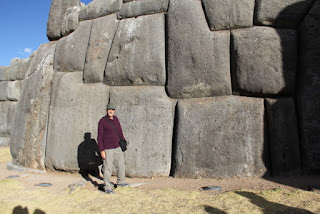The Incas demanded all peoples under their jurisdiction to contribute to the national coffer in a variety of ways but at the same time ensured peace and adequate basic needs to all people. They found a way to incorporate local authority figures into their political elite thus reducing resistance to their rule.
As a local guide took us around the city and environs we explored what is now called the Temple of the Sun, Sacsayhuaman, Qenqo and other sites. Our guide noted repeatedly that original perceptions about the rule of the Inca were being tested and many were dubious, reflecting biases of the time. He noted for instance that there is no substantial evidence to support the idea that the Inca made human sacrifices. Earlier interpretations were based more on creating a rationale by the institutional church to support suppression of local religious culture than on real fact. Many of the perceptions about cultic activity now are undermined and rather reflect a rather sophisticated management and governance system that was able to govern many peoples over hundreds of years.
Unfortunately 80 to 90% of knowledge about the Inca was destroyed by the Spanish and Catholic church of the time. Much is left to speculation.
 The site of Sacsayhuaman is an amazing tribute to one of the chief Inca rulers who built it as a monument to his prestige and capability. The stones in this structure are up to 120 tonnes in weight and were carved in a quarry about 3 kms from their final destination. After they were cut and carved to the necessary shape they were carted to the monument site. Once fitted they moulded perfectly to one another.
The site of Sacsayhuaman is an amazing tribute to one of the chief Inca rulers who built it as a monument to his prestige and capability. The stones in this structure are up to 120 tonnes in weight and were carved in a quarry about 3 kms from their final destination. After they were cut and carved to the necessary shape they were carted to the monument site. Once fitted they moulded perfectly to one another.I tried to put the blade of my pocket knife between the stones and could not insert it. Each stone is a different shape and size. From the air the structure evidently looks like the head of a puma from a lateral view.
The guide noted that by current estimates, using manual labour, it would have taken 20,000 people 50 years to complete the project working non stop. Imagine the logistics involved of feeding, transportation, family needs, etc. In reality we do not know how this project was achieved.
Clearly this calls for more reading and understanding on my part. Minimaly though we here have the remnants of an incredible empire that achieved admirable capacities. Almost all of the knowlege of the Incas has been tragically lost.

No comments:
Post a Comment